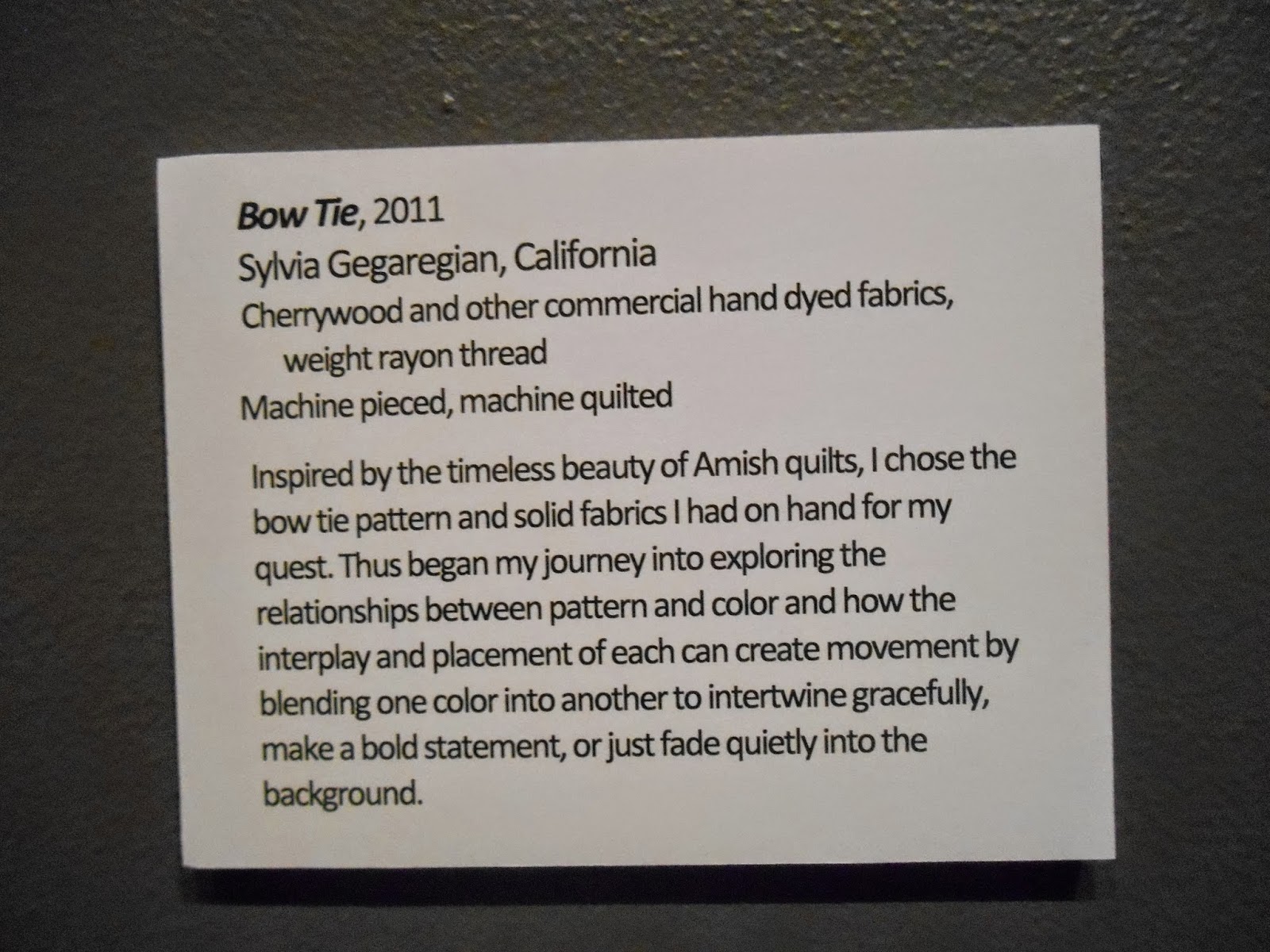 |
| c. 1955 |
So she bagged it on making art and became an English major. Years later, she thought, what the hell, why not try making quilts? She'd learned to sew in the eighth grade and from her mother, and besides, her father didn't think sewing was worth much, was merely "loving hands at home," (his words), and he wouldn't bother to criticize it. (A rocky relationship, yes.)
Turned out making quilts was pretty easy to do.
I bought the book "Quilts, Quilts, Quilts!" (Diana McClun and Laura Nownes) to learn the basics--seam allowances, rotary cutter, patterns--and plunged ahead. Wow! Fun! So accessible! And I could make a cover for a bed!
Cut to the present.
On Saturday, Rebecca and I made a pilgrimage to the San Jose Quilt and Textile Museum to a traveling show of about half of the quilts accepted for the 2013 Quilt National. Subtitle: "The Best of Contemporary Quilts."
If you're not a quilter, I'll can tell you that it is an extremely prestigious juried show. It is A Big Deal.
Rebecca had a quilt accepted for the 2001 show and her quilt mini-group gave her a champagne toast:
 |
| Full Circle, Rebecca Rohrkaste, 2001 |
Imagine my disappointment halfway through the first gallery on Saturday when we had yet to come across a pieced quilt, let alone something you could put on a bed or--in my case--even remotely imagine doing myself.
"Art departments have hijacked the show!" I wailed to Rebecca.
"Surface design artists," she corrected gently. "This has been going on for years."
Google "surface design" and you find a description like this one: "Surface design techniques can be used to create unique, original fabrics for your art quilts. Common techniques include fabric dyeing, painting, and printing, as well as digital image transfer. There are many different approaches within each of these categories: screen printing, immersion dyeing, stamping, and more...[my bold]--
What we were viewing was much more complicated than any woman who'd traveled the Oregon Trail or run an Amish household in Pennsylvania or quilted with feed sacks in the Depression would do, much less the beleaguered daughter of an art professor who finally found a safe way to express herself by running up quilts on a Featherweight.
Don't get me wrong: The quilts were inventive and displayed impeccable workmanship. We admired them. Neither of us has a "my-five-year-old-could-do this" attitude about modern art: Rebecca went to the Rhode Island School of Design, and I minored in History of Art and love contemporary art. We both think dyeing your own fabric is a fine idea, but so is buying commercially available fabric.
And so are quilts you can put on a bed created by people who aren't out to create "art" and who haven't necessarily gone to art school.
We finally came across a pieced quilt, and I took an illegal picture:
 |
| Bow Tie, Sylvia Gregaregian, 2011 |
I swear I saw Rebecca's shoulders drop two or three inches when she came across this beauty.
 |
| The beautiful machine quilting |
We perked up. My disappointment ebbed. But I left the show unmoved.
This morning I found a fascinating--and validating-- blog post by quilter Kathleen Loomis about this show. She counted only two quilts out of 85 as being pieced in this show of what's supposed to be "the pantheon of contemporary quilting."
She says, "I like the fact that the quilt world has been so adventurous in trying and accepting new techniques and approaches...but have we gotten so enamored of the new that we have totally disrespected and discarded the old?"
I agree. I'd just like to see a celebration of traditional techniques used to create quilts that are wonderful, appealing, and warm. In all senses of that word.
After the show, Rebecca and I went to my sister's house and picked Blenheim apricots from her tree.
 |
| Rebecca descending the ladder |
 |
| Bountiful! |
 |
| An apron pocketful |
 |
| Ready to be brought home to ripen |




2 comments:
The attraction to quilting for me has always been functional art. Beautiful ceramics on the table are the same as well as hand crafted furniture. Perhaps I view quilts as craft, rather than art, but there is nothing better than sleeping under a quilt that you have made. And my pieced quilts go into the washing machine and dryer making them something that can be used in everyday life.
Here, here, totally agree!
Post a Comment